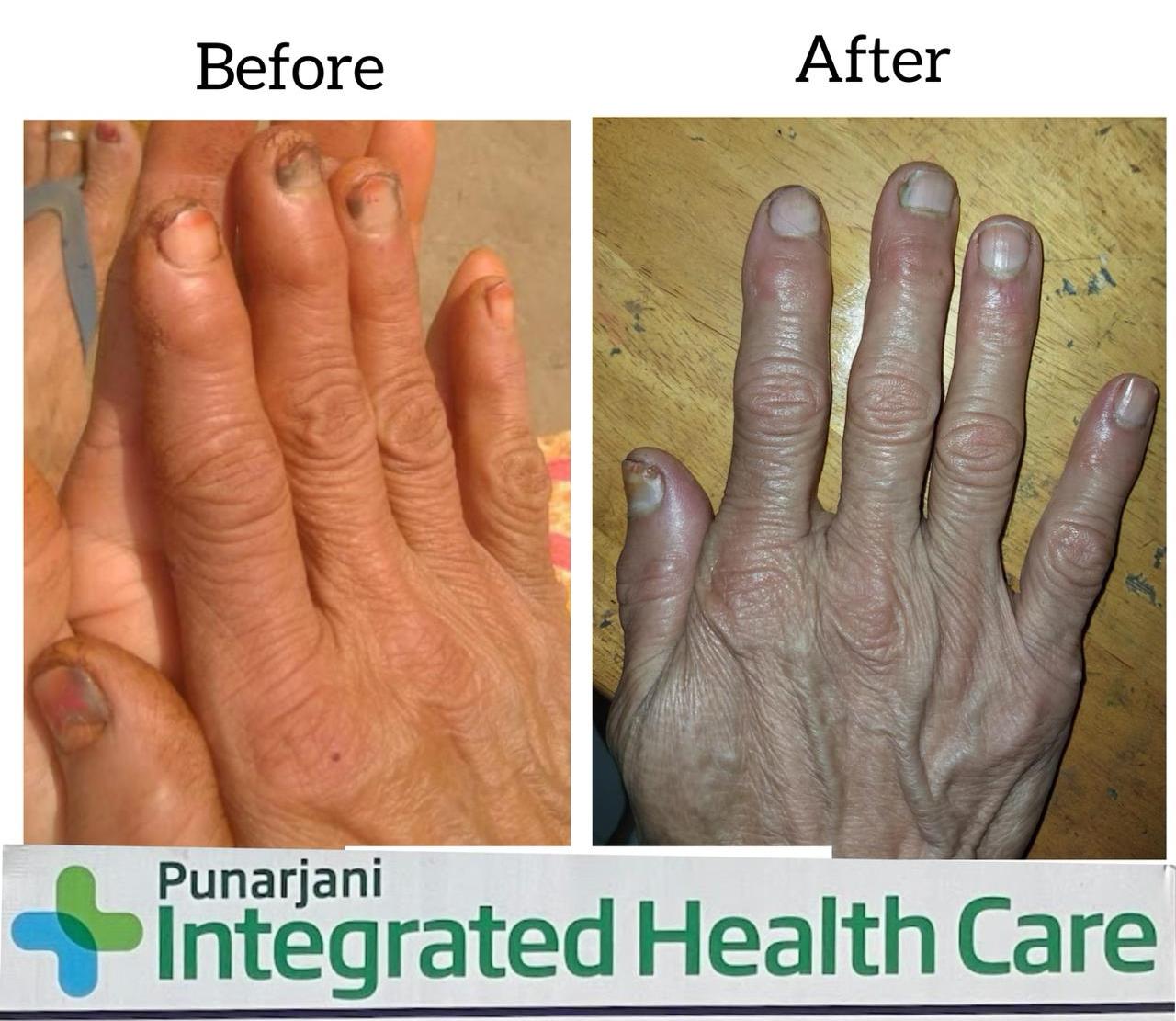Case Photos
(Our patients' photos reflect their transformative journeys.)
“𝐎𝐧𝐞 𝐨𝐟 𝐨𝐮𝐫 𝐩𝐚𝐭𝐢𝐞𝐧𝐭𝐬 𝐡𝐚𝐝 𝐛𝐞𝐞𝐧 𝐬𝐭𝐫𝐮𝐠𝐠𝐥𝐢𝐧𝐠 𝐰𝐢𝐭𝐡 𝐡𝐲𝐩𝐨𝐭𝐡𝐲𝐫𝐨𝐢𝐝𝐢𝐬𝐦 𝐟𝐨𝐫 𝟖 𝐲𝐞𝐚𝐫𝐬. 𝐃𝐞𝐬𝐩𝐢𝐭𝐞 𝐭𝐚𝐤𝐢𝐧𝐠 𝐚𝐥𝐥𝐨𝐩𝐚𝐭𝐡𝐢𝐜 𝐦𝐞𝐝𝐢𝐜𝐢𝐧𝐞 𝐝𝐚𝐢𝐥𝐲, 𝐬𝐡𝐞 𝐟𝐨𝐮𝐧𝐝 𝐧𝐨 𝐫𝐞𝐥𝐢𝐞𝐟—𝐡𝐞𝐫 𝐰𝐞𝐢𝐠𝐡𝐭 𝐤𝐞𝐩𝐭 𝐢𝐧𝐜𝐫𝐞𝐚𝐬𝐢𝐧𝐠, 𝐚𝐧𝐝 𝐡𝐞𝐫 𝐬𝐲𝐦𝐩𝐭𝐨𝐦𝐬 𝐩𝐞𝐫𝐬𝐢𝐬𝐭𝐞𝐝.”
But in just 𝟑 𝐦𝐨𝐧𝐭𝐡𝐬 𝐨𝐟 𝐡𝐨𝐦𝐞𝐨𝐩𝐚𝐭𝐡𝐢𝐜 𝐭𝐫𝐞𝐚𝐭𝐦𝐞𝐧𝐭, her 𝐓𝐒𝐇 𝐥𝐞𝐯𝐞𝐥𝐬 𝐧𝐨𝐫𝐦𝐚𝐥𝐢𝐳𝐞𝐝, and she no longer needs daily medication! Her 𝐰𝐞𝐢𝐠𝐡𝐭 𝐡𝐚𝐬 𝐚𝐥𝐬𝐨 𝐫𝐞𝐝𝐮𝐜𝐞𝐝 𝐧𝐚𝐭𝐮𝐫𝐚𝐥𝐥𝐲.
Homeopathy treats the 𝐫𝐨𝐨𝐭 𝐜𝐚𝐮𝐬𝐞, offering a 𝐠𝐞𝐧𝐭𝐥𝐞 𝐚𝐧𝐝 𝐥𝐚𝐬𝐭𝐢𝐧𝐠 solution. If you or your loved ones are facing similar health challenges, homeopathy could be the answer!
Book Appointment For Consultation
Nail infection Successfully Treated by Dr. Anisha

Nail fungus, medically referred to as onychomycosis, is a prevalent condition that can affect all fingernails. While not typically debilitating, it can lead to nail distortion, discoloration, and hinder normal finger movements. Despite not posing a significant health threat, nail fungus can cause discomfort and potentially damage nails by penetrating deeper tissues.
Factors contributing to nail fungus include exposure to detergents or water, frequent manicures, and nail margin injuries. This condition can manifest as either acute or chronic and tends to be overlooked in its initial stages, potentially leading to chronicity or deeper tissue involvement. Initially presenting as subtle color changes, it progresses to noticeable nail distortion over time.
Conventional treatments for nail fungus typically involve oral or topical antifungal medications. Prevention strategies include maintaining good nail hygiene, wearing breathable footwear, and avoiding barefoot walking to mitigate infection risks.
Homeopathy offers a holistic approach to addressing nail fungus, infection, and toenail fungus, though its effectiveness can vary depending on the individual. Consulting with a healthcare professional is advisable to explore suitable treatment options and ensure comprehensive care.
Book Appointment For Consultation
Foot corn successfully treated by Dr. Anisha

Patient review: She took allopathy and she has done surgery but corn resurfaced. With help of homoeopathic treatment, the corn was addressed without the need of the surgery. She is from hyderabad. Her treatment is going on.
Causes
Corns and calluses develop as protective measures against skin damage caused by repetitive pinching, rubbing, or irritation. Common culprits include ill-fitting shoes, whether too tight or too loose, or featuring excessively high heels. Tight socks or stockings, deformed toes, prolonged walking on hard surfaces or downhill, and occupations or hobbies involving consistent pressure on specific areas can also contribute to the formation of calluses.

